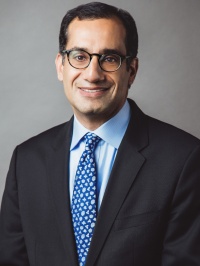This article was published in the September 2016 issue of STORES Magazine.
RETAIL PEOPLE
Shobi Khan drives the day-to-day operations of Chicago-based General Growth Properties, the shopping center giant with a portfolio that includes 128 properties in 40 states.
GGP has some of the nation’s most luxurious retail addresses including Water Tower Place in Chicago, Glendale Galleria in suburban Los Angeles, Park Meadows in Denver, Tysons Galleria outside Washington, D.C., and Ala Moana Center in Honolulu.
Khan runs GGP’s investment team, which handles acquisitions, dispositions, joint-ventures recapitalizations and corporate transactions. He also leads GGP’s asset management team (property management, tenant coordination, sustainability, energy, capital projects, field marketing), which is where the company’s commitment to sustainability has roots.
The 1.8 billion visitors to GGP properties find solar arrays being installed at a rapid rate and a growing number of electric vehicle charging stations in parking lots. Khan’s team works behind the scenes to educate tenants about greener options with respect to everything from recycling programs to in-store lighting and heating and air conditioning. For these efforts and more, GGP earned a Green Star in 2014 and 2015 from the Global Real Estate Sustainability Benchmark.
Khan, who regularly bikes to work, is fully onboard with these efforts. Before joining GGP, he served as the U.S. chief investment officer at Bentall Kennedy, a real estate investment advisory firm, where he was responsible for U.S. investment activity. Khan also spent 11 years at Equity Office Properties Trust and prior to that, worked for Katz Hollis and Arthur Andersen.

Shobi Khan
Chief Operating Officer
GGP
Chicago
How did sustainability come to play such an important role at GGP?
Sustainability is deeply embedded throughout our operations — it’s one of the disciplines of the asset management team and has always been a focus of driving productivity from our properties.
We firmly believe that at the heart of any responsible corporate citizen is an honest sensitivity to the business’s impact on the community. A typical mall operation requires a significant amount of energy and produces a significant amount of waste. We work side-by-side with our tenants to employ green choices for energy efficient fixtures and equipment and aggressive recycling programs.
GGP is committed to being an environmentally responsible business: We refer to our investments as “conscious capitalism,” doing right for our world while at the same time becoming more efficient operators. We think robust sustainability initiatives are not only good for the environment, but they’re also beneficial to our bottom line.
Let’s stay with the bottom line. There are so many sustainability efforts and initiatives at GGP — how does it shake out?
Like any large-scale property, malls require a significant amount of energy and resources to maintain. At the same time, however, efficient and sustainably run malls can also be intrinsically green, particularly as lots of people are sharing resources.
There’s recent research that suggests shopping in a physical store is actually greener than shopping online. Shoppers can reduce their carbon footprint by up to 7 percent and even have a positive environmental impact when they forgo e-commerce [for shopping at bricks-and-mortar stores].
As for our commitment to solar, I’m proud to say that our solar-generation projects currently underway will rank GGP among the top 10 U.S. companies by solar capacity, according to 2015 Solar Energy Industries Association rankings.
To give you some background, in 2012 GGP invested in solar power at five of our sites — four New Jersey properties and Ala Moana Center. The installations, which have the capability to provide a combined 6.3 megawatts, supply power to the malls’ common areas. On average, these deliver approximately 10 to 20 percent of each mall’s total electricity demand.
These solar installations provided greater cost savings than expected, and as a result of the success of these five solar projects, we’re installing solar arrays at 28 additional properties that will be generating electricity by the end of this year. So we’re constantly evaluating the portfolio to expand our solar generation capacity.
Do you share sustainable efforts with customers?
Much of our sustainability efforts are “behind the curtain,” not always visible or noticeable to the public. Recent accomplishments such as reducing our water consumption by 64 million gallons or diverting more than 54,300 tons of waste from landfills may not always be apparent, but we think these efforts are critical to our sustainability mission.
GGP understands that energy conservation and sustainable buildings lead to increased efficiencies, lower operating costs and a solid return on investment. Since 2011, we have reduced our electricity consumption by over 210 million kilowatt hours — enough electricity to power more than 22,000 average U.S. homes for one year.
What new sustainability initiatives are on the table for discussion at GGP?
We’re always looking at new technology to reduce our energy consumption. LED lighting continues to be refined, leading to more efficient lighting using less electricity. The same for heating, cooling and ventilation: New high-efficiency rooftop HVAC units can provide conditioned air using less electricity. That would lead to lower costs, lower … emissions and improved indoor air quality. And technology advances have led to increased efficiency of photovoltaic solar panels.
Some of the most exciting new technologies are fuel cells and battery storage systems. Fuel cells converting natural gas to electricity would allow us to take a property completely off the power grid with self-generated on-site power. Battery storage systems would allow us to expand our solar capacity and use battery storage technology to power properties after sunset. That would reduce our evening electricity load on the power grid. We’re also exploring evaporative cooling HVAC systems with energy recovery, allowing us to cool our properties and generate electricity at the same time.